2025-01-18 Diagonal Lines
Description
Convert image to just a few distinct colors and then diagonally cluster points into lines.
Images
Inputs

Plotter Preview
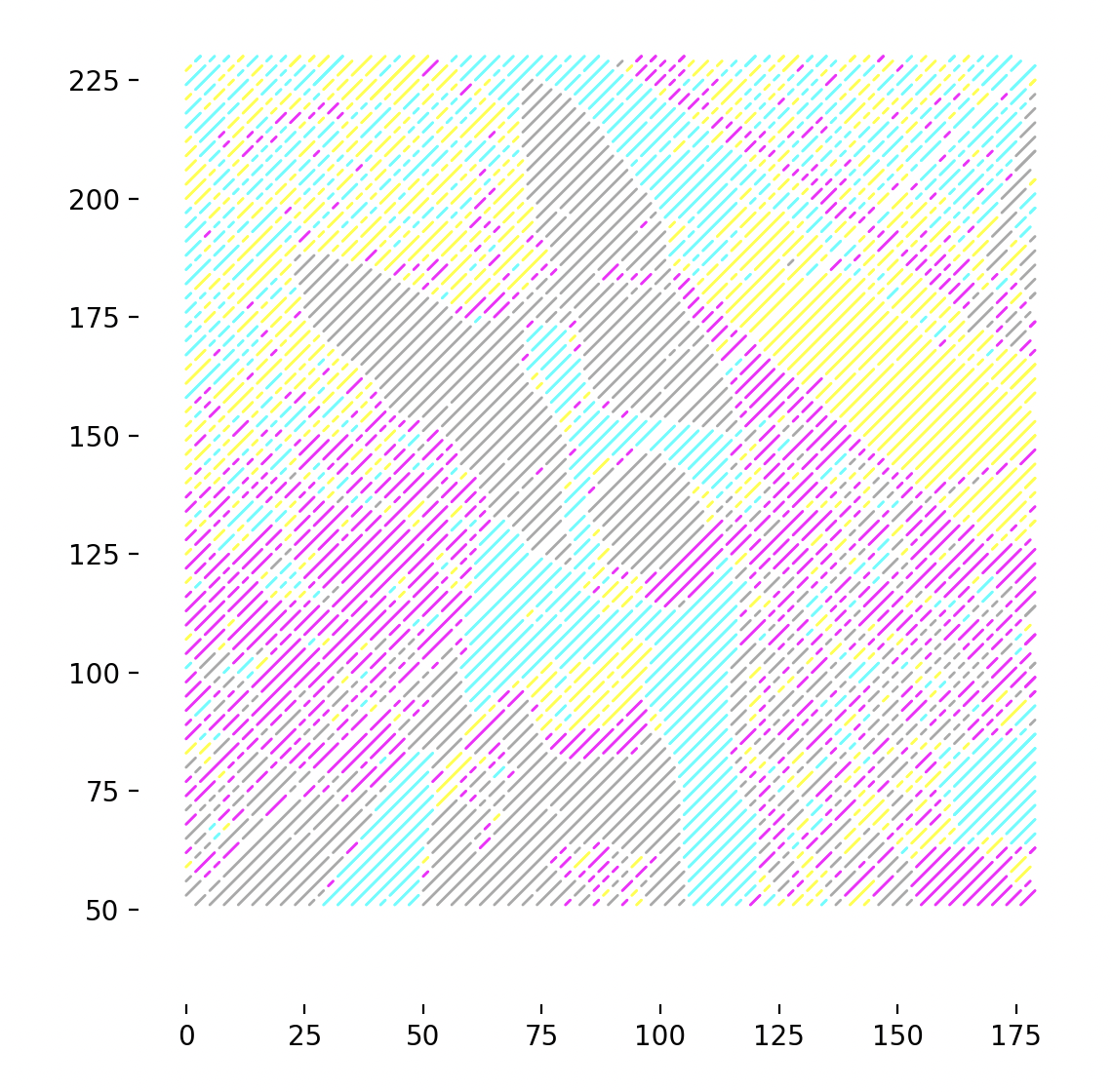
Code
warning
This code may or may not run and is intended more as a reference. Additionally, it was most likely not written with the latest version of the library. To ensure compatibility, check the date of this post against the version history and install the corresponding version.
# Take a photo, process it into N buckets where each bucket has roughly the
# same number of pixels.
from random import shuffle
from gcode2dplotterart import Plotter3D
from gcode2dplotterart.experimental_photo_utils import (
load_image,
resize_image,
grayscale_image,
bucket_image_even_pixel_count,
)
image_path = "./test.jpeg"
GAP_BETWEEN_DIAGONALS = 3
GAP_BETWEEN_COLINEAR_LINES = 1
X_MIN = 0
X_MAX = 180
Y_MIN = 40
Y_MAX = 230
Z_PLOTTING_HEIGHT = 0
Z_NAVIGATION_HEIGHT = 4
PLOTTER_WIDTH = X_MAX - X_MIN
PLOTTER_HEIGHT = Y_MAX - Y_MIN
OFFSET_X = 0
OFFSET_Y = 0
LAYERS = [
# 33
{
"title": "darkgrey",
"color": "darkgrey",
"line_width": 1.0,
},
# 40
{
"title": "cyan",
"color": "cyan",
"line_width": 1.0,
},
# 18
# 15
{
"title": "magenta",
"color": "magenta",
"line_width": 1.0,
},
{
"title": "yellow",
"color": "yellow",
"line_width": 1.0,
},
]
shuffle(LAYERS)
image = load_image(image_path, preview=True)
image = resize_image(
image, max_width=PLOTTER_WIDTH, max_height=PLOTTER_HEIGHT, preview=True
)
print("max dimensions", PLOTTER_WIDTH, PLOTTER_HEIGHT)
print("resized to", image.shape)
image = grayscale_image(image, method="luminosity", preview=True)
image = bucket_image_even_pixel_count(
image, layer_count=len(LAYERS), preview=True
)
plotter = Plotter3D(
title="Diagonal Lines",
x_min=X_MIN,
x_max=X_MAX,
y_min=Y_MIN,
y_max=Y_MAX,
z_plotting_height=Z_PLOTTING_HEIGHT,
z_navigation_height=Z_NAVIGATION_HEIGHT,
feed_rate=10000,
output_directory="./output",
handle_out_of_bounds="Error",
return_home_before_plotting=True,
)
for layer in LAYERS:
plotter.add_layer(
layer["title"], color=layer["color"], line_width=layer["line_width"]
)
rows, cols = image.shape[:2]
def is_point_in_bounds(x, y):
return x >= 0 and x < cols and y >= 0 and y < rows
def create_path(start_x, start_y):
path = []
x = start_x
y = start_y
while is_point_in_bounds(x, y):
path.append((y, x))
x += 1
y -= 1
return path
paths: list[tuple[int, int]] = []
start_col = 0
last_row = 0
for row in range(0, rows, GAP_BETWEEN_DIAGONALS):
paths.append(create_path(start_col, row))
last_row = row
# This should take care of the gap between the last row and the first column.
delta = abs(last_row - rows) - 1
print(f"Delta: {delta}")
# # Process origin at row n
start_row = rows - 1
for col in range(delta, cols, GAP_BETWEEN_DIAGONALS):
paths.append(create_path(col, start_row))
for path in paths:
line_start = path[0]
color = LAYERS[image[line_start]]["title"]
index = 0
while index < len(path):
point = path[index]
current_color = LAYERS[image[point]]["title"]
if current_color == color:
index += 1
if index >= len(path):
row_start, col_start = line_start
row_end, col_end = path[-1]
plotter.layers[color].add_line(
col_start + X_MIN + OFFSET_X,
Y_MAX - row_start + OFFSET_Y,
col_end + X_MIN + OFFSET_X,
Y_MAX - row_end + OFFSET_Y,
)
break
continue
else:
row_start, col_start = line_start
row_end, col_end = point
plotter.layers[color].add_line(
col_start + X_MIN + OFFSET_X,
Y_MAX - row_start + OFFSET_Y,
col_end + X_MIN + OFFSET_X,
Y_MAX - row_end + OFFSET_Y,
)
index += GAP_BETWEEN_COLINEAR_LINES
if index >= len(path):
row_start, col_start = line_start
row_end, col_end = path[-1]
plotter.layers[color].add_line(
col_start + X_MIN + OFFSET_X,
Y_MAX - row_start + OFFSET_Y,
col_end + X_MIN + OFFSET_X,
Y_MAX - row_end + OFFSET_Y,
)
break
point = path[index]
color = LAYERS[image[point]]["title"]
line_start = point
plotter.preview()
plotter.save()